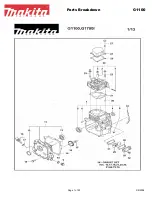
Xtium-CL PX4 User's Manual
Xtium-CL PX4 Reference
•
41
CVI/CCF File Parameters Used
Shaft Encoder Enable = X, where:
•
If X = 1, Shaft Encoder is enabled
•
If X = 0, Shaft Encoder is disabled
Shaft Encoder Pulse Drop = X, where:
•
X = number of trigger pulses ignored between valid triggers
Shaft Encoder Pulse Multiply = X, where:
•
X = number of trigger pulses generated for each shaft encoder pulses
Shaft Encoder Pulse Drop/Multiply Order = X, where:
•
If X = 1, the drop operation will be done first, followed by the multiplier operation
•
If X = 0 or 2, the multiplier operation will be done first, followed by the drop operation
Shaft Encoder Direction = X, where:
•
X = 0, Ignore direction
•
X = 1, Forward steps are detected by pulse order A/B (forward motion)
•
X = 2, Forward steps are detected by pulse order B/A (reverse motion)
Note: For information on camera configuration files, see the Sapera Acquisition Parameters
Reference Manual (OC-SAPM-APR00).
Virtual Frame Trigger for Line Scan Cameras
When using line scan cameras, a frame buffer is allocated in host system memory to store
captured video lines. To control when a video line is stored as the first line in this “virtual” frame
buffer, an external frame trigger signal is used. For fixed length frames, the Sapera vertical
cropping parameter controls the number of lines sequentially grabbed and stored in the virtual
frame buffer. For variable length frames, the External Frame Trigger (when a level or dual input
type is selected) controls the number of lines sequentially grabbed up to the maximum of lines in
the virtual frame buffer.
Virtual Frame Trigger Timing Diagram
The following timing diagram shows an example of grabbing 10 video lines from a line scan camera
and the use of a virtual frame trigger to define when a video line is stored at the beginning of the
virtual frame buffer. The virtual frame trigger signal (generated by some external event) connects
to the Xtium-CL PX4 trigger input.
Virtual frame trigger can be RS-422, TTL, 12V, or 24V industry standard, and be rising or falling
edge active, active high or low, or double pulse rising or falling edge.
In this example, virtual frame trigger control is configured for rising edge trigger.
Virtual frame trigger connects to the Xtium-CL PX4 via the External Trigger Input 1 & 2 inputs.
•
Trigger Input #1 on connector J1: pin 8
•
Trigger Input #2 on connector J1: pin 9
Camera control signals are active at all times. These continually trigger the camera acquisition
in order to avoid corrupted video lines at the beginning of a virtual frame.
The camera control signals are either timing controls on Xtium-CL PX4 shaft encoder inputs, or
line triggers generated internally by the Xtium-CL PX4.
The Sapera vertical cropping parameter specifies the number of lines captured.
Synchronization Signals for a 10 Line Virtual Frame
The following timing diagram shows the relationship between External Frame Trigger input,
External Shaft Encoder input (one phase used with the second terminated), and camera control
output to the camera.
















































